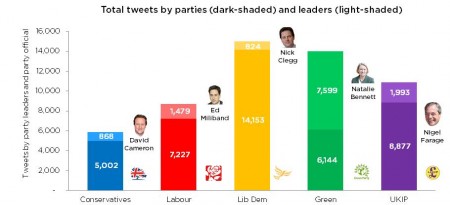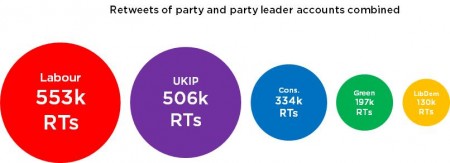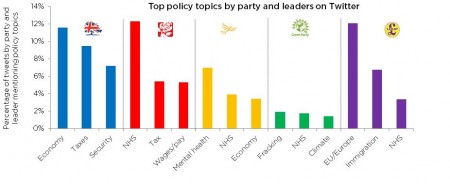#GE2015: how Twitter came of age in British politics
06 May 2015
Gregory Gillette
Trends
As the general election enters the final 24 hours, we can clearly see the role social media played in each party’s strategy. More importantly we can also see how it has, for the first time, taken on a central role in the campaign. How much the parties spoke, what they were saying, and how much people cared can all help give us an indication of how social media has matured into a key political tool.
The Conservatives, for example, are a striking example of how you can say everything by saying very little. David Cameron and his party sent out just under 6000 tweets in the last year, about 16 every day. Compare this to Liberal Democrats, who managed more than 1.7 tweets every hour.
Two facts explain this. Firstly, Conservative voters are much older (on average, 59 years old) than UK Twitter users (32 years old on average). Second, the Conservatives would like you to think their actions in office speak louder than other parties’ words and promises.

* Chart shows number of tweets by respective UK parties (lower bar portion) and leaders (upper bar portion). Data collected between 06/05/2014 and 06/05/2015. Source: Twitter
The Conservatives built an aura of success around themselves and their leader. According to YouGov, Cameron is comfortably the most liked political leader overall, meaning the party doesn’t see much need to do a lot of convincing through its social media.
Those same YouGov data show also that Natalie Bennett is the second-most liked leader among 18-24s, aka Twitter users, explaining the Green’s unique strategy of running the leader out front.
Demographically UKIP are at an even greater disadvantage on Twitter than the Conservatives. Further handicapping them, they have the weakest youth wing on Twitter, and are the second-weakest at the party and leadership level. In response UKIP have replicated their primary media strategy of being the centre of controversy and therefore conversation. This has rewarded Nigel Farage and UKIP with 506k retweets, the second most of any party.

* Chart shows number of retweets of respective UK party and leader accounts combined. Data collected between 05/05/2014 and 05/05/2015.Source: Twitter
In terms of retweet success, it should be no surprise Labour came in first. Labour itself is well-followed and its young supporters are digital natives. Furthermore, that young Labour base is organised through Young Labour (the second-most followed youth wing) into an army of activists and door-knockers. They apply a similar mass-action strategy to social media, creating the Twitter equivalent of the Occupy movement’s “human megaphone”.
The struggles of the Greens beg questions, however. They are also young and have the strongest youth branch on Twitter, with over 12k followers. Remembering as well, they have been the second most vocal party, the Greens speak to an important social media lesson: speaking with deeper substance is more important than speaking volumes.
Indeed, part of the Greens’ problems might come from the fact that fewer than eight percent of tweets by the Greens or Natalie Bennett mentioned their top policy issues. Even their top issue, fracking, only got a nod in 1.9 percent of Green tweets:

* Chart shows percentage of tweets by parties and leaders mentioning key policy-related words for top three policies. Data based on all tweets between 28/04/2014 and 28/04/2015.Source: Twitter
The Conservatives, by contrast, were disciplined in staying on message. Their top three issues, economy, taxes, and security, together feature in nearly a third of Conservative Tweets.
Labour were also quite focused, particularly on the NHS and the need to choose them to safeguard it. UKIP for their part managed to mention either Europe or Immigration in about a fifth of their tweets. The LibDems showed caution in choosing mental health, an issue that can fit into a larger coalition plan.
Overall these data allow us to summarise a few key points about the campaign on Twitter for each party.
- The Conservatives, true to their name, ran a tight ship with fewer, but to-the-point tweets.
- Labour made the social media case for strong central leadership supported by well-organised masses.
- The Liberal Democrats spoke, a lot, but were seemingly unheard – another similarity between social and the rest of the media.
- The Green Party played to their strengths and showed promise, but ultimately paid for having a lack of depth and focus.
- UKIP, as expected, spoke of nothing but Europe and Immigration, and managed to be exceptionally loud in doing so.
What is clear from these top-line indicators is how well all the parties have by now adapted to Twitter as a key campaigning platform. The differences in their social media strategies are clear, though they parallel the nuances of each party’s overall strategy, rather than any lack of understanding of new media. Twitter is no longer a campaign afterthought and its acceptance means that the core of campaigns are being run through inherently more democratic and transparent media than ten years ago. Not to overstate the importance of social media’s rise in politics, but we know at least for now that Twitter has come of age in British politics.